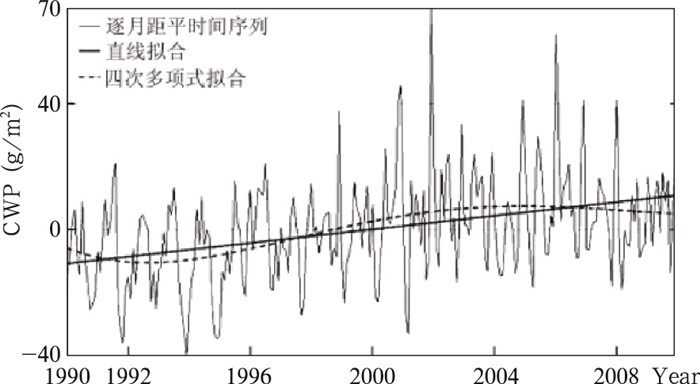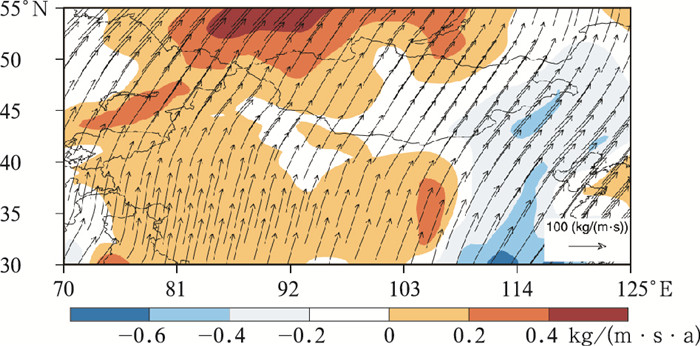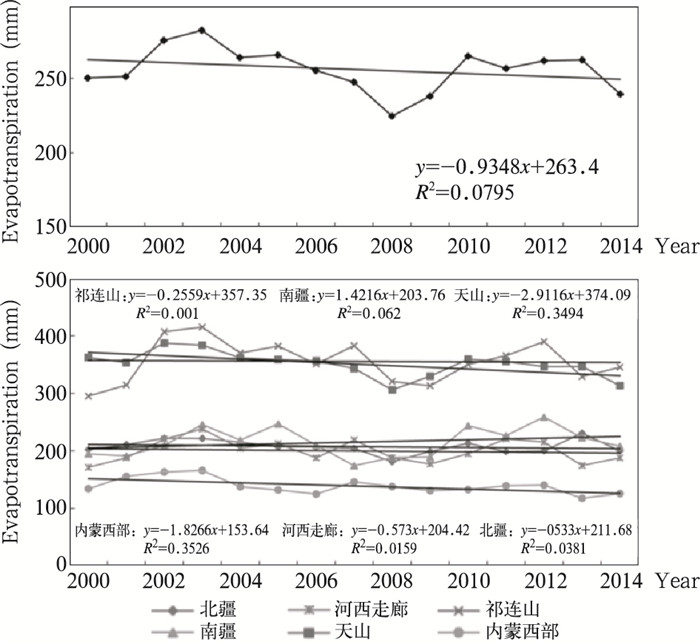中国气象学会主办。
文章信息
- 刘玉芝, 常姝婷, 华珊, 黄建平. 2018.
- LIU Yuzhi, CHANG Shuting, HUA Shan, HUANG Jianping. 2018.
- 东亚干旱半干旱区空中水资源研究进展
- A review of the research on atmospheric water resources over arid and semi-arid regions of East Asia
- 气象学报, 76(3): 485-492.
- Acta Meteorologica Sinica, 76(3): 485-492.
- http://dx.doi.org/10.11676/qxxb2018.004
-
文章历史
- 2017-06-29 收稿
- 2017-11-29 改回
干旱半干旱区覆盖着全球1/3的陆地面积,这里降水稀少、水资源短缺,对人类活动和全球气候变化的响应十分敏感。全球主要有8个干旱半干旱区,其中,东亚干旱半干旱区是全球干旱半干旱带的主要组成部分(图 1黑框所示区域),主要包括中国西北地区、华北中西部、蒙古高原以及中亚部分地区,中国42%的国土处于东亚干旱半干旱区。近年来,随着全球气候的逐渐变暖,干旱半干旱区的气候变化比其他地区更为显著,且呈现出暖干化趋势(姚玉璧等,2005;王毅荣等,2006)。水分循环作为地-气系统物质循环中最重要的环节,能够通过海陆间的水循环过程为陆地带来丰富的水汽,并在特定条件下形成云进而形成空中水资源。空中水资源对干旱半干旱地区暖干气候有重要的调节作用(Zhai,et al,1997),是影响干旱半干旱地区可持续发展的重要方面。

|
| 图 1 东亚干旱半干旱区分布 (Huang, et al, 2014) Figure 1 Spatial distribution of arid and semiarid regions in Asia (Huang, et al, 2014) |
大气含水是空中水资源的重要组成部分,传统定义中,空中水资源是指大气中的水汽成分和云(封彩云等,2009),包括气态的水(汽)及固、液态的水(云)。该定义是大气领域的传统定义,给出的是大气中水汽及云的状态量,即某区域上空某时刻或一个较长时期平均的水汽含量和云水含量。以往研究中,已有大量关于水汽含量(曹丽青等,2005)、水汽输送(张强等,2007)及云水资源(陈勇航等,2009)瞬时及平均意义上的研究。然而,水汽和云水资源的平均状态量无法反映一定时间内水汽和云水的再生更新量(王光谦等,2016)。因此,从对降水产生贡献的意义来讲,空中水资源指某地区在某时段大气中水汽和云水的累积量。
本文针对东亚干旱半干旱区,对关于该地区空中水资源特征及影响该地区空中水资源的主要因子等方面的中外研究成果进行系统回顾,展望该领域未来的研究重点。
2 东亚干旱半干旱区水汽和云分布特征 2.1 水汽分布及变化由于温度较低、水汽输送不充足以及青藏高原大地形的阻塞作用,使得东亚干旱半干旱区大气中水汽含量较低,且受地形影响显著。在无任何大气环流作用的假定下,背风坡大气中的水汽含量较迎风坡低(张强等,2007;杨青等,2013);在有大气环流影响情况下,中国西北干旱半干旱区大气中的水汽主要集中在东、西部的天山北侧及塔里木河流域盆地,而中部水汽含量较少(俞亚勋等,2003)。总体而言,中国西北干旱半干旱区的水汽自西北和东南部向西北干旱区中部降低,在平均状态下,青藏高原边坡、东亚季风区、天山及祁连山地区是水汽含量的高值区(王宝鉴等,2006);而华北干旱区的水汽含量则呈现由东南到西北逐渐降低的特征(曹丽青等,2005)。分析表明,20世纪80年代中期之后,东亚干旱半干旱区对流层底部的水汽明显增多,其中夏季增多最显著(白庆梅,2010),而西北干旱半干旱地区空中水汽含量自50年代末至80年代中期呈明显下降趋势,而随着全球气候变暖的加剧,从80年代后期开始水汽也呈现波动上升趋势(图 2)。

|
| 图 2 中国西北地区1958—2000年平均年总空中水汽含量距平百分率及其趋势拟合的变化曲线 (俞亚勋等,2003) Figure 2 Percentage anomaly of annual water vapor amount averaged in 1958-2000 over Northwest China and its fitting curve (Yu, et al, 2003) |
东亚干旱半干旱区云特性的研究针对西北干旱半干旱区的较多。研究表明,西北干旱半干旱区的云量与地形有很好的一致性:塔里木盆地是云量最少的地区,天山—昆仑山—祁连山一带存在着云量的极大值区,云层较厚,云水路径较高(宜树华等,2003;李兴宇等,2008)。在全球气候变暖背景下,中国西北地区高云呈明显下降趋势,中、低云量之和呈上升趋势(陈勇航等,2007),其中,天山、帕米尔高原、柴达木盆地、横断山脉等地区明显存在低云量增多的趋势(刘洪利等,2003),并有研究(宋松涛等,2013)指出,中国西北部分地区云水路径总体上呈现上升趋势(图 3),同时呈现“东正西负”的东西向变化差异以及“北正南负”的反相位特征。也有研究表明,华北地区总云量有减少趋势(刘洪利等,2003),其中,中、高云量存在明显增多的趋势(周喜讯,2015);内蒙古地区总云量及低、中云量呈自西向东逐渐增多,高云量自西南向东北逐渐减少(图 3)。

|
| 图 3 西北地区云水路径月平均时间序列(宋松涛等,2013) Figure 3 Diagram of time series of monthly mean cloud water path in Northwest China (Song, et al, 2013) |
针对东亚干旱半干旱区水资源匮乏的现状,空中水资源的开发利用成为该区域可持续发展的重要议题。从这一角度来看,能够转化为降水的空中水资源才是可被利用的。王光谦等(2016)将空中水资源定义为在一定时段(如年)内累计的可产生降水的空中水汽的更新量。并将总水汽输入通量减去背景水汽输入通量(多年无云天气的晴空水汽含量),得到随天气过程进入区域内的额外水汽,即定义为空中水资源量。空中水资源的降水转化率为降水量除以输入的空中水资源和局地蒸散之和。
3.1 水汽输送利用欧洲中心提供的1979—2015年水平分辨率为0.5°×0.5°的ERA-Interim逐月再分析资料,对东亚干旱半干旱区的整层水汽输送进行了分析(图 4)。研究表明,1979—2015年,东亚干旱半干旱区大气中的水汽主要来自西南方向的水汽输送,研究时段内该区域西部的整层水汽净输送量呈现增多趋势,而东部和中部部分地区呈现弱的减少趋势。另据大量对西北干旱区的研究表明,中国西北地区水汽主要来自纬向水汽输送,且西北干旱半干旱区降水偏多时低纬度赤道附近的印度洋、太平洋上均有比较活跃的水汽上升异常运动(任宏利等,2004;王宝鉴等,2004;何金海等,2005;张强等,2007;蔡英等,2015),1979—2008年西北干旱区的整层年水汽含量略呈增加趋势,其中,夏季水汽总收入呈现显著增加趋势(刘芸芸等,2011)。针对塔里木盆地的研究表明,1978—2003年塔里木盆地水平方向水汽净输入量呈减少趋势,垂直方向呈增多趋势(吴永萍等,2010)。

|
| 图 4 东亚干旱半干旱区1979—2015年平均整层水汽输入通量变化趋势 Figure 4 Trends of total transported water vapor over arid and semi-arid regions of East Asia during 1979-2015 |
蒸散是下垫面向大气的水汽输送,包括地表蒸发和植物蒸腾,它是地表水分平衡和能量平衡的重要组成部分,决定着地-气相互作用的强度,对全球水循环以及气候变化具有十分重要的意义。邓兴耀等(2017)对中国西北干旱区蒸散的研究结果表明,2000—2014年该区域蒸散量总体较小,15年间全区年均蒸散量呈波动变化,总体呈现弱的减小趋势,各亚区的蒸散量在时间序列上呈不同程度的减小趋势,其中天山的变化率最大,祁连山的变化最小,仅南疆的蒸散量有增加趋势(图 5)。贺添等(2014)对中国蒸散时空格局的变化研究表明,2001—2010年黄土高原蒸散增大趋势显著,而内蒙古中东部以及新疆北部蒸散呈显著减小趋势。其他也有很多针对东亚干旱半干旱区蒸散的研究(李宝富等,2011;刘春雨等,2014)。然而,到目前为止,对陆面实际蒸散量的测量和估算问题一直没有得到很好的解决,许多研究工作中使用的蒸散资料误差较大。同时由于缺乏对不同方法观测或估算的蒸散量的正确理解,往往在研究蒸散量的过程中出现不合理的结果,有关学者已经把蒸散的观测分析作为主要研究内容(张强等,2011),关于东亚干旱半干旱区蒸散量的问题有待进一步研究。

|
| 图 5 2000—2014年西北干旱区年际蒸散变化(邓兴耀等,2017) Figure 5 Inter-annual variation of evapotranspiration in arid region of Northwest China from 2000-2014 (Deng, et al, 2017) |
程国栋等(2006)指出,中国西北地区的区域水分内循环很不活跃,降水的转化效率很低,并指出,在西北地区全年区域水汽总输入量中,只有15%左右能形成降水,85%的水汽都是越境而过,输出到中国东部地区。而西北地区年总水汽蒸发量中,只有约7%在区域内重新形成降水,返回到地面,而93%蒸发的水汽随气流输送出境外。王可丽等(2005)研究表明,在青藏高原以北的中国西北大部分地区,大气水汽输送为辐散,表明水汽输送没有转化成当地的降水;而在中国西北地区的青藏高原主体和西北地区东部则为水汽输送的辐合区,水汽输送对当地降水贡献较大。王光谦等(2016)研究了位于中国北方半干旱区的黄河流域空中水资源特征,并指出黄河源区空中水资源的丰度较上中游地区高,降水转化率偏低。已有对东亚干旱半干旱区空中水资源的研究大多集中在对水汽、云水资源的空间分布特征研究方面(张良等,2007),将其与是否产生有效降水的联系仍不够。
4 空中水资源的主要影响因子及讨论在影响空中水资源的因素中,大气环流是最主要的因子。其中,水平大气环流决定空中水汽的输送通道以及水汽的收支,垂直环流中的下沉气流导致该区域干旱化加剧并影响中、低云的形成,对空中水资源有较大的影响。分析水平大气环流与东亚干旱半干旱区水汽输送的相互影响可以看出,东亚季风、西南季风、高原季风、西风带、来自西西伯利亚的西北气流均在一定程度上对该区域不同地区的水汽含量产生影响(张强等,2007;华维等,2012;王颖等,2015;齐玉磊等,2015)。垂直环流同样会影响东亚干旱半干旱区的空中水资源,有研究指出,夏季在中国西北干旱区和华北半干旱区存在干旱半干旱经圈环流,干旱半干旱经圈环流在40°—47°N有深厚的下沉气流,次下沉气流使中蒙夏季气候干旱化加剧(钱正安等, 1998, 2001, 2011)。
Gaffen等(1992)研究认为,水汽与地表温度呈线性关系,对于较高温度的气旋来讲,形成降水的水汽70%来自空中已存在的水汽,其余的来自地表的水汽蒸发,根据克劳修斯-克拉珀龙方程,全球变暖加剧时,地表蒸散使得空气中已存在的水汽含量增加(Trenberth, 1999; Trenberth,et al,2003),水汽也将通过对长、短波辐射的吸收进一步对温度产生影响(Charney,1975)。也有研究表明,在西北干旱半干旱区的地-气系统中,地面气温升高,促使地面蒸发剧烈,水分循环加快,导致中、低云量增多进而致使降水增多,同时由于中、低云产生的降水增多,能够上升形成高云的水汽减少,所以高云量减少,最终导致地面气温减低或者减缓地面气温上升的幅度(Yu,et al,2004)。目前针对东亚干旱半干旱区云水资源和温度关系的研究成果较少,但云和水汽一样,是影响地区气候变化的一个重要的因子,尤其与温度之间有很明显的反馈作用(丁守国等,2004)。
随着对空中水资源研究的深入,可知下垫面特征,例如植被覆盖情况、地表反照率、地表粗糙度等同样会对局地空中水资源造成影响。丁一汇等(2005)研究指出,内蒙古地区土地荒漠化加剧了中国华北、西北地区的干旱,植被变化对东亚冬夏季风强度,偏南季风也有一定程度的影响,有利于暖湿空气的向北输送,使得中国北方地区水汽含量升高。吕世华等(1999)通过对比分析证实西北地区植被扩展,季风加强有利于青藏高原及中国北方地区大气含水量增多;植被退化,荒漠化加剧,季风减弱则使北方地区大气含水量减少。Xue等(1993)指出,由于荒漠化作用,蒸发量的减少导致蒙古国和内蒙古地区地表能量收支的变化,影响该地区的大气环流减弱导致当地的大气水汽含量减少。因此,由地表植被变化造成的大气水平及垂直环流的变化(曾红玲,2010;郑益群等, 2002a, 2002b;周锁铨,1990;符淙斌等,2001;花婷等,2014),将明显影响到各区域的水汽输送情况,使各区域的大气水汽含量变化。
总体来说,上述主要影响因子通过影响东亚干旱半干旱区的水汽输送及蒸散,进而在特定的天气条件下水汽和云水资源转化为降水,对地表水资源进行补给。除上述主要因子外,空中水资源还受到其他因子的影响。因此,在未来开发和利用空中水资源用以应对东亚干旱半干旱地区的干旱化气候环境问题中,需要弄清影响该地区空中水资源的主要因子,深入理解各因子影响该地区空中水资源的机理。目前,大多数的研究成果主要针对研究区大气中水汽含量和云平均状态的分布和变化特征进行研究,而目前对空中水资源的理解中(王光谦等,2016),通过将水汽与降水转化联系起来,可将空中水资源重新定义为在一定时段内累计可产生降水的空中水汽的更新量。然而,目前为止,从有可能产生多少降水的角度对空中水资源特征的研究尚少,因此,真正与降水相关联的空中水资源的变化特征,目前仍不清楚,有待系统深入地研究。
| 白庆梅. 2010. 亚洲干旱/半干旱区近几十年区域气候变化[D]. 兰州: 兰州大学. Bai Q M. 2010. Region change of Asian Arid and semiarid area in recent years[D]. Lanzhou: Lanzhou University (in Chinese) http://www.wanfangdata.com.cn/details/detail.do?_type=degree&id=Y1702754 |
| 蔡英, 宋敏红, 钱正安, 等. 2015. 西北干旱区夏季强干、湿事件降水环流及水汽输送的再分析. 高原气象, 34(3): 597–610. Cai Y, Song M H, Qian Z A, et al. 2015. Reanalyses of precipitation circulation and vapor transportation of severe dry and wet events in summer in arid region of Northwest China. Plateau Meteor, 34(3): 597–610. DOI:10.7522/j.issn.1000-0534.2015.00049 (in Chinese) |
| 曹丽青, 余锦华, 葛朝霞. 2005. 华北地区大气水汽含量特征及其变化趋势. 水科学进展, 16(3): 439–443. Cao L Q, Yu J H, Ge Z X. 2005. Water vapor content in the atmosphere and its variation trend over North China. Adv Water Sci, 16(3): 439–443. (in Chinese) |
| 陈勇航, 陈艳, 黄建平, 等. 2007. 中国西北地区云的分布及其变化趋势. 高原气象, 26(4): 741–748. Chen Y H, Chen Y, Huang J P, et al. 2007. Distribution and variation trend of cloud over Northwestern China. Plateau Meteor, 26(4): 741–748. (in Chinese) |
| 陈勇航, 毛晓琴, 黄建平, 等. 2009. 西北典型地域条件下云量的对比分析. 气候与环境研究, 14(1): 77–84. Chen Y H, Mao X Q, Huang J P, et al. 2009. Comparison of cloud coverage over Northwestern China with respect to typical regions. Climatic Environ Res, 14(1): 77–84. (in Chinese) |
| 程国栋, 王根绪. 2006. 中国西北地区的干旱与旱灾——变化趋势与对策. 地学前缘, 13(1): 3–14. Cheng G D, Wang G X. 2006. Changing trend of drought and drought disaster in northwest China and countermeasures. Earth Sci Front, 13(1): 3–14. (in Chinese) |
| 邓兴耀, 刘洋, 刘志辉, 等. 2017. 中国西北干旱区蒸散发时空动态特征. 生态学报, 37(9): 2994–3008. Deng X Y, Liu Y, Liu Z H, et al. 2017. Temporal-spatial dynamic change characteristics of evapotranspiration in arid region of Northwest China. Acta Ecol Sinica, 37(9): 2994–3008. (in Chinese) |
| 丁守国, 石广玉, 赵春生. 2004. 利用ISCCP D2资料分析近20年全球不同云类云量的变化及其对气候可能的影响. 科学通报, 49(12): 1301–1306. Ding S G, Shi G Y, Zhao C S. 2004. Analyzing global trends of different cloud types and their potential impacts on climate by using the ISCCP D2 dataset. Chin Sci Bull, 49(12): 1301–1306. (in Chinese) |
| 丁一汇, 李巧萍, 董文杰. 2005. 植被变化对中国区域气候影响的数值模拟研究. 气象学报, 63(5): 613–621. Ding Y H, Li Q P, Dong W J. 2005. A numerical simulation study of the impacts of vegetation changes on regional climate in China. Acta Meteor Sinica, 63(5): 613–621. DOI:10.11676/qxxb2005.060 (in Chinese) |
| 封彩云, 王式功, 尚可政, 等. 2009. 中国北方水汽与云和降水的关系. 兰州大学学报(自科版), 45(4): 30–36. Feng C Y, Wang S G, Shang K Z, et al. 2009. Relationship between water vapor with cloud and precipitation in the North China. J Lanzhou Univ (Nat Sci), 45(4): 30–36. (in Chinese) |
| 符淙斌, 袁慧玲. 2001. 恢复自然植被对东亚夏季气候和环境影响的一个虚拟试验. 科学通报, 46(14): 1199–1203. Fu C B, Yuan H L. 2001. A virtual numerical experiment to understand the impacts of recovering natural vegetation on the summer climate and environmental conditions in East Asia. Chin Sci Bull, 46(14): 1199–1203. DOI:10.3321/j.issn:0023-074X.2001.14.015 (in Chinese) |
| 何金海, 刘芸芸, 常越. 2005. 西北地区夏季降水异常及其水汽输送和环流特征分析. 干旱气象, 23(1): 10–16. He J H, Liu Y Y, Chang Y. 2005. Analysis of summer precipitation anomaly and the feature of water vapor transport and circulation in Northwest China. Arid Meteor, 23(1): 10–16. (in Chinese) |
| 贺添, 邵全琴. 2014. 基于MOD16产品的我国2001-2010年蒸散发时空格局变化分析. 地球信息科学学报, 16(6): 979–988. He T, Shao Q Q. 2014. Spatial-temporal variation of terrestrial evapotranspiration in China from 2001 to 2010 using MOD16 products. J Geo-Inf Sci, 16(6): 979–988. (in Chinese) |
| 华维, 范广洲, 王炳赟. 2012. 近几十年青藏高原夏季风变化趋势及其对中国东部降水的影响. 大气科学, 36(4): 784–794. Hua W, Fan G Z, Wang B Y. 2012. Variation of Tibetan Plateau summer monsoon and its effect on precipitation in East China. Chinese J Atmos Sci, 36(4): 784–794. DOI:10.3878/j.issn.1006-9895.2012.11173 (in Chinese) |
| 花婷, 王训明. 2014. 东亚干旱半干旱区沙漠化与气候变化相互影响研究进展. 地理科学进展, 33(6): 841–852. Hua T, Wang X M. 2014. Research progresses on the interaction between desertification and climate change in arid and semiarid East Asia. Prog Geogr, 33(6): 841–852. DOI:10.11820/dlkxjz.2014.06.013 (in Chinese) |
| 李宝富, 陈亚宁, 李卫红, 等. 2011. 基于遥感和SEBAL模型的塔里木河干流区蒸散发估算. 地理学报, 66(9): 1230–1238. Li B F, Chen Y N, Li W H, et al. 2011. Remote sensing and the SEBAL Model for estimating evapotranspiration in the Tarim River. Acta Geogr Sinica, 66(9): 1230–1238. DOI:10.11821/xb201109008 (in Chinese) |
| 李兴宇, 郭学良, 朱江. 2008. 中国地区空中云水资源气候分布特征及变化趋势. 大气科学, 32(5): 1094–1106. Li X Y, Guo X L, Zhu J. 2008. Climatic distribution features and trends of cloud water resources over China. Chinese J Atmos Sci, 32(5): 1094–1106. (in Chinese) |
| 刘春雨, 董晓峰, 刘英英. 2014. 西北干旱区遥感ET与潜在ET对气候变化的响应:以甘南草原区域为例. 兰州大学学报(自科科学版), 50(2): 194–199, 207. Liu C Y, Dong X F, Liu Y Y. 2014. Remote sensing ET and potential ET response to climate change in arid grassland:A case study of South Gansu, China. J Lanzhou Univ (Nat Sci), 50(2): 194–199, 207. (in Chinese) |
| 刘洪利, 朱文琴, 宜树华, 等. 2003. 中国地区云的气候特征分析. 气象学报, 61(4): 466–473. Liu H L, Zhu W Q, Yi S H, et al. 2003. Climatic analysis of the cloud over China. Acta Meteor Sinica, 61(4): 466–473. DOI:10.11676/qxxb2003.045 (in Chinese) |
| 刘芸芸, 张雪芹. 2011. 西北干旱区空中水资源的时空变化特征及其原因分析. 气候变化研究进展, 7(6): 385–392. Liu Y Y, Zhang X Q. 2011. Variations of atmospheric water resources over the arid region of Northwest China and its causes. Adv Climate Change Res, 7(6): 385–392. (in Chinese) |
| 吕世华, 陈玉春. 1999. 西北植被覆盖对我国区域气候变化影响的数值模拟. 高原气象, 18(3): 416–424. Lü S H, Chen Y C. 1999. The influence of northwest China afforestation on regional climate in China. Plateau Meteor, 18(3): 416–424. (in Chinese) |
| 齐玉磊, 冯松, 黄建平, 等. 2015. 高原夏季风对中东亚干旱半干旱区夏季降水的影响. 高原气象, 34(6): 1566–1574. Qi Y L, Feng S, Huang J P, et al. 2015. Influence of Plateau summer monsoon on summer precipitation in the Arid and Semi-Arid regions of the central and East Asia. Plateau Meteor, 34(6): 1566–1574. DOI:10.7522/j.issn.1000-0534.2014.00088 (in Chinese) |
| 钱正安, 吴统文, 吕世华, 等. 1998. 夏季西北干旱气候形成的数值模拟——高原地形和环流场等的影响. 大气科学, 22(5): 753–762. Qian Z A, Wu T W, Lü S H, et al. 1998. Numerical simulation of Northwest China Arid climate formation:Effects of the Qinghai-Xizang Plateau terrain and circulation field. Sci Atmos Sinica, 22(5): 753–762. (in Chinese) |
| 钱正安, 吴统文, 梁潇云. 2001. 青藏高原及周围地区的平均垂直环流特征. 大气科学, 25(4): 444–454. Qian Z A, Wu T W, Liang X Y. 2001. Feature of mean vertical circulation over the Qinghai-Xizang Plateau and its neighborhood. Chinese J Atmos Sci, 25(4): 444–454. (in Chinese) |
| 钱正安, 宋敏红, 李万源, 等. 2011. 全球、中蒙干旱区及其部分地区降水分布细节. 高原气象, 30(1): 1–12. Qian Z A, Song M H, Li W Y, et al. 2011. Global, China-Mongolia Arid-and Semiarid-Areas (CMASA) and the details of precipitation distribution in part regions of CMASA. Plateau Meteor, 30(1): 1–12. (in Chinese) |
| 任宏利, 张培群, 李维京, 等. 2004. 中国西北东部地区春季降水及其水汽输送特征. 气象学报, 62(3): 365–374. Ren H L, Zhang P Q, Li W J, et al. 2004. Characteristics of precipitation and water vapor transport during springtime in the eastern Northwest China. Acta Meteor Sinica, 62(3): 365–374. DOI:10.11676/qxxb2004.037 (in Chinese) |
| 宋松涛, 张武, 陈艳, 等. 2013. 中国西北地区近20年云水路径时空分布特征. 兰州大学学报(自然科学版), 49(6): 787–793, 798. Song S T, Zhang W, Chen Y, et al. 2013. Temporal and spatial distributions of cloud water path over Northwestern China in the recent 20 years. J Lanzhou Univ (Nat Sci), 49(6): 787–793, 798. (in Chinese) |
| 王宝鉴, 黄玉霞, 何金海, 等. 2004. 东亚夏季风期间水汽输送与西北干旱的关系. 高原气象, 23(6): 912–918. Wang B J, Huang Y X, He J H, et al. 2004. Relation between Vapour transportation in the period of East Asian summer monsoon and drought in Northwest China. Plateau Meteor, 23(6): 912–918. (in Chinese) |
| 王宝鉴, 黄玉霞, 陶健红, 等. 2006. 西北地区大气水汽的区域分布特征及其变化. 冰川冻土, 28(1): 15–21. Wang B J, Huang Y X, Tao J H, et al. 2006. Regional features and variations of water vapor in Northwest China. J Glaciol Geocryol, 28(1): 15–21. (in Chinese) |
| 王光谦, 李铁键, 李家叶, 等. 2016. 黄河流域源区与上中游空中水资源特征分析. 人民黄河, 38(10): 79–82. Wang G Q, Li T J, Li J Y, et al. 2016. Analysis of sky water resources in the source region and the upper-middle region of the Yellow River basin. Yellow River, 38(10): 79–82. DOI:10.3969/j.issn.1000-1379.2016.10.016 (in Chinese) |
| 王可丽, 江灏, 赵红岩. 2005. 西风带与季风对中国西北地区的水汽输送. 水科学进展, 16(3): 432–438. Wang K L, Jiang H, Zhao H Y. 2005. Atmospheric water vapor transport from westerly and monsoon over the Northwest China. Adv Water Sci, 16(3): 432–438. (in Chinese) |
| 王毅荣, 林纾, 陆登荣. 2006. 陇中半干旱区月气候对全球气候变化的响应特征. 宁夏大学学报(自然科学版), 27(1): 93–96. Wang Y R, Lin S, Lu D R. 2006. Characteristics of month temperature over middle area in Gansu Province response for variation of the Globle temperature. J Ningxia Univ (Nat Sci Ed), 27(1): 93–96. (in Chinese) |
| 王颖, 李栋梁. 2015. 变暖背景下青藏高原夏季风变异及其对中国西南气候的影响. 气象学报, 73(5): 910–924. Wang Y, Li D L. 2015. Variation of the Tibetan Plateau summer monsoon under the background of global warming and its impact on the climate in southwestern China. Acta Meteor Sinica, 73(5): 910–924. (in Chinese) |
| 吴永萍, 王澄海, 沈永平. 2010. 1948-2009年塔里木盆地空中水汽输送时空分布特征. 冰川冻土, 32(6): 1074–1083. Wu Y P, Wang C H, Shen Y P. 2010. Spatial-temporal distribution of water vapor transportation over Tarim Basin during 1948-2009. J Glaciol Geocryol, 32(6): 1074–1083. (in Chinese) |
| 杨青, 姚俊强, 赵勇, 等. 2013. 伊犁河流域水汽含量时空变化及其和降水量的关系. 中国沙漠, 33(4): 1174–1183. Yang Q, Yao J Q, Zhao Y, et al. 2013. Spatial-temporal variation of water vapor and its relationship with the precipitation in the Ili River Basin. J Desert Res, 33(4): 1174–1183. DOI:10.7522/j.issn.1000-694X.2013.00166 (in Chinese) |
| 姚玉璧, 王毅荣, 李耀辉, 等. 2005. 中国黄土高原气候暖干化及其对生态环境的影响. 资源科学, 27(5): 146–152. Yao Y B, Wang Y R, Li Y H, et al. 2005. Climate warming and drying and its environmental effects in the Loess Plateau. Resour Sci, 27(5): 146–152. (in Chinese) |
| 宜树华, 刘洪利, 李维亮, 等. 2003. 中国西北地区云时空分布特征的初步分析. 气象, 29(1): 7–11. Yi S H, Liu H L, Li W L, et al. 2003. Spatial and temporal distributions of cloud over northwest of China. Meteor Mon, 29(1): 7–11. DOI:10.7519/j.issn.1000-0526.2003.01.002 (in Chinese) |
| 俞亚勋, 王劲松, 李青燕. 2003. 西北地区空中水汽时空分布及变化趋势分析. 冰川冻土, 25(2): 149–156. Yu Y X, Wang J S, Li Q Y. 2003. Spatial and temporal distribution of water vapor and its variation trend in atmosphere over Northwest China. J Glaciol Geocryol, 25(2): 149–156. (in Chinese) |
| 曾红玲, 季劲钧, 吴国雄. 2010. 全球植被分布对气候影响的数值试验. 大气科学, 34(1): 1–11. Zeng H L, Ji J J, Wu G X. 2010. Numerical experiment of the influence of global vegetation distribution on climate. Chinese J Atmos Sci, 34(1): 1–11. (in Chinese) |
| 张良, 王式功, 尚可政, 等. 2007. 祁连山区空中水资源研究. 干旱气象, 25(1): 14–20, 47. Zhang L, Wang S G, Shang K Z, et al. 2007. Research on vapor and precipitation resources over the Qilian Mountain Area. Arid Meteor, 25(1): 14–20, 47. (in Chinese) |
| 张强, 张杰, 孙国武, 等. 2007. 祁连山山区空中水汽分布特征研究. 气象学报, 65(4): 633–643. Zhang Q, Zhang J, Sun G W, et al. 2007. Research on atmospheric water-vapor distribution over Qilianshan Mountains. Acta Meteor Sinica, 65(4): 633–643. DOI:10.11676/qxxb2007.058 (in Chinese) |
| 张强, 张之贤, 问晓梅, 等. 2011. 陆面蒸散量观测方法比较分析及其影响因素研究. 地球科学进展, 26(5): 538–547. Zhang Q, Zhang Z X, Wen X M, et al. 2011. Comparisons of observational methods of land surface evapotranspiration and their influence factors. Adv Earth Sci, 26(5): 538–547. (in Chinese) |
| 郑益群, 钱永甫, 苗曼倩, 等. 2002a. 植被变化对中国区域气候的影响Ⅰ:初步模拟结果. 气象学报, 60(1): 1–16. Zheng Y Q, Qian Y F, Miao M Q, et al. 2002a. The effects of vegetation change on regional climate Ⅰ:Simulation results. Acta Meteor Sinica, 60(1): 1–16. (in Chinese) |
| 郑益群, 钱永甫, 苗曼倩, 等. 2002b. 植被变化对中国区域气候的影响Ⅱ:机理分析. 气象学报, 60(1): 17–30. Zheng Y Q, Qian Y F, Miao M Q, et al. 2002b. The effects of vegetation change on regional climateⅡ:Mechanisms. Acta Meteor Sinica, 60(1): 17–30. (in Chinese) |
| 周锁铨. 1990. 我国西北下垫面影响大气的初步数值试验. 气象科学, 10(3): 248–258. Zhou S Q. 1990. A preliminary numerical experiment of influence of underlying surface on the atmospheric circulation over North-Western China. Sci Meteor Sinica, 10(3): 248–258. (in Chinese) |
| 周喜讯. 2015. 全球和中国地区云量和云的光学厚度的长期变化趋势研究[D]. 北京: 中国气象科学研究院. Zhou X X. 2015. Researches on long-term variation trends of cloud amount and optical thickness in China and the world[D]. Beijing: The Chinese Academy of Meteorological Sciences (in Chinese) http://cdmd.cnki.com.cn/Article/CDMD-85101-1015305957.htm |
| Charney J G. 1975. Dynamics of deserts and drought in the Sahel. Quart J Roy Meteor Soc, 101(428): 193–202. DOI:10.1002/(ISSN)1477-870X |
| Gaffen D J, Elliott W P, Robock A. 1992. Relationships between tropospheric water vapor and surface temperature as observed by radiosondes. Geophys Res Lett, 19(18): 1839–1842. DOI:10.1029/92GL02001 |
| Huang J P, Wang T H, Wang W C, et al. 2014. Climate effects of dust aerosols over East Asian arid and semiarid regions. J Geophys Res, 119(19): 11398–11416. |
| Trenberth K E. 1999. Atmospheric moisture recycling:Role of advection and local evaporation. J Climate, 12(5): 1368–1381. DOI:10.1175/1520-0442(1999)012<1368:AMRROA>2.0.CO;2 |
| Trenberth K E, Dai A G, Rasmussen R M, et al. 2003. The changing character of precipitation. Bull Amer Meteor Soc, 84(9): 1205–1217. DOI:10.1175/BAMS-84-9-1205 |
| Xue Y K, Shukla J. 1993. The influence of land surface properties on Sahel climate.Part Ⅰ:Desertification. J Climate, 6(12): 2232–2245. DOI:10.1175/1520-0442(1993)006<2232:TIOLSP>2.0.CO;2 |
| Yu R C, Wang B, Zhou T J. 2004. Climate effects of the deep continental stratus clouds generated by the Tibetan Plateau. J Climate, 17(13): 2702–2713. DOI:10.1175/1520-0442(2004)017<2702:CEOTDC>2.0.CO;2 |
| Zhai P M, Eskridge R E. 1997. Atmospheric water vapor over China. J Climate, 10(10): 2643–2652. DOI:10.1175/1520-0442(1997)010<2643:AWVOC>2.0.CO;2 |
 2018, Vol. 76
2018, Vol. 76


